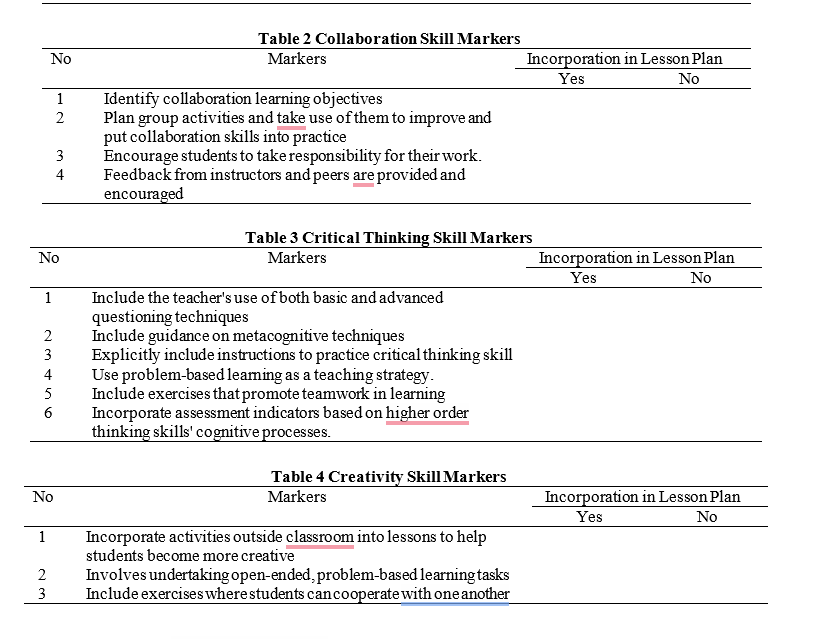HOW ENGLISH TEACHERS’ LESSON PLANS INCORPORATE LEARNING AND INNOVATION SKILLS
DOI:
https://doi.org/10.30736/ej.v11i1.1016Keywords:
4C’s skills, lesson plan, eight-gradeAbstract
English instruction in Indonesia now includes learning and innovation skills, also known as the 4Cs: communication, cooperation, critical thinking, and creativity. The purpose of this study is to determine how much eighth-grade English teachers use 4Cs skills in their lesson plans. This content analysis uses information from 10 eighth-grade lesson plans from various schools in Jakarta and Bekasi. The learning objectives, learning materials, methods, and assessment were the main topics of the lesson plan components. Even though there were dominating indicators from each skill—communication skill indicators were the most common and creative indicators were the least—nine lesson plans were identified to incorporate 4C. Furthermore, learning objectives were only found in the communication, collaboration, and critical thinking skills; learning media was found in the communication skills; and assessment was found in the communication, collaboration, and critical thinking skills. The lesson plan components that integrated all skills were learning activities and other lesson plan components.
Downloads
References
(NEA), N. E. A. (n.d.). Preparing 21st Century Students for a Global Society: An Educator’s Guide to the “Four Cs.” 2015.
Ariyana, Y., Pudjiastuti, A., Bestary, R., & Zamromi, Z. (2018). Buku Pegangan Pembelajaran Keterampilan Berpikir Tingkat Tinggi: Program Peningkatan Kompetensi Pembelajaran Berbasis Zonasi. Direktorat Jendral Guru dan Tenaga Kependidikan.
Bedir, H. (2019a). Developing a Framework for the Integration of 21st Century Learning and Innovation Skills into Pre-Service ELT Teachers’ Practicum. International Online Journal of Education and Teaching, 6(4), 828–843.
Bedir, H. (2019b). Pre-service ELT teachers’ beliefs and perceptions on 21st century learning and innovation skills (4Cs). Journal of Language and Linguistic Studies, 15(1), 231–246. https://doi.org/10.17263/jlls.547718
Chrisyarani, D. D., & Setiawan, D. A. (2021). 4C-Based Cooperative Learning Model Through Lesson Study Activities on Indonesian Course for Elemantary School. Proceedings of the 2nd Annual Conference on Social Science and Humanities (ANCOSH 2020), 542(Ancosh 2020), 338–343. https://doi.org/10.2991/assehr.k.210413.078
Cresswell, J. W. (2009). Research Design: Qualitative, Quantitative, and Mixed Methods Approaches. Third Edition. SAGE. https://doi.org/10.1080/14675980902922143
Dwimayanti, K, Dantes, N, and Suarni, K. (2020). Pengembangan Rencana Pelaksanaan Pembelajaran (RPP) Tema Kegiatanku Kelas I Berbasis Kecakapan Belajar dan Berinovasi Abad 21. PENDASI: Jurnal Pendidikan Dasar Indonesia, 4(1), 1–10.

Downloads
Published
How to Cite
Issue
Section
License
Copyright (c) 2024 Ellis Tamela, Tara Mustikaning Palupi, Hanip Pujiati

This work is licensed under a Creative Commons Attribution 4.0 International License.








